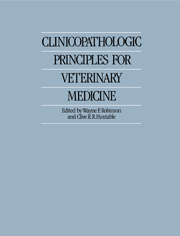Book contents
- Frontmatter
- Contents
- Contributors
- Preface
- Acknowledgements
- 1 The relationship between pathology and medicine
- 2 The immune system
- 3 The hematopoietic system
- 4 Acid–base balance
- 5 The respiratory system
- 6 The cardiovascular system
- 7 The alimentary tract
- 8 The liver and exocrine pancreas
- 9 The urinary system
- 10 The endocrine glands
- 11 The skin
- 12 The skeletal system
- 13 The nervous system
- 14 Muscle
- 15 Metabolic disease
- 16 The reproductive system
- Index
9 - The urinary system
Published online by Cambridge University Press: 19 January 2010
- Frontmatter
- Contents
- Contributors
- Preface
- Acknowledgements
- 1 The relationship between pathology and medicine
- 2 The immune system
- 3 The hematopoietic system
- 4 Acid–base balance
- 5 The respiratory system
- 6 The cardiovascular system
- 7 The alimentary tract
- 8 The liver and exocrine pancreas
- 9 The urinary system
- 10 The endocrine glands
- 11 The skin
- 12 The skeletal system
- 13 The nervous system
- 14 Muscle
- 15 Metabolic disease
- 16 The reproductive system
- Index
Summary
The mammalian urinary system is constructed to generate, store and finally expel the familiar liquid known as urine, a product extracted from the flowing bloodstream by the kidneys. Disorders of the urinary system relate largely to three activities – production, conduction and storage of urine. A failure of any of these activities threatens the health, and ultimately the life of the afflicted animal, which is another way of saying that the urinary system is a vital and indispensible organ system. The total failure of urine formation or expulsion will lead to death in a few days, while lesser degrees of malfunction can give rise to numerous clinical abnormalities.
The kidneys create urine as a vehicle for the elimination of toxic or useless metabolic end products while simultaneously regulating the homeostatic balance of a range of crucial substances. The kidneys are also the site of production of several important hormones and of the degradation of others. The activity of the kidneys is tightly integrated with, and greatly influenced by, the cardiovascular system, the neurohypophysis, the adrenal cortex and the parathyroid gland. Any primary disease in one may be reflected in disturbances of function in the other.
In the lower urinary tract, the storage and voiding of urine are heavily subject to, amongst other things, the state of the autonomic nervous system, spinal cord and pelvic nerves.
In the face of such a diversity of possible clinical ramifications and interactions, the clinician has no choice but to come to grips with the fascinating complexities of the urinary system in health and disease.
- Type
- Chapter
- Information
- Clinicopathologic Principles for Veterinary Medicine , pp. 216 - 248Publisher: Cambridge University PressPrint publication year: 1988
- 1
- Cited by



